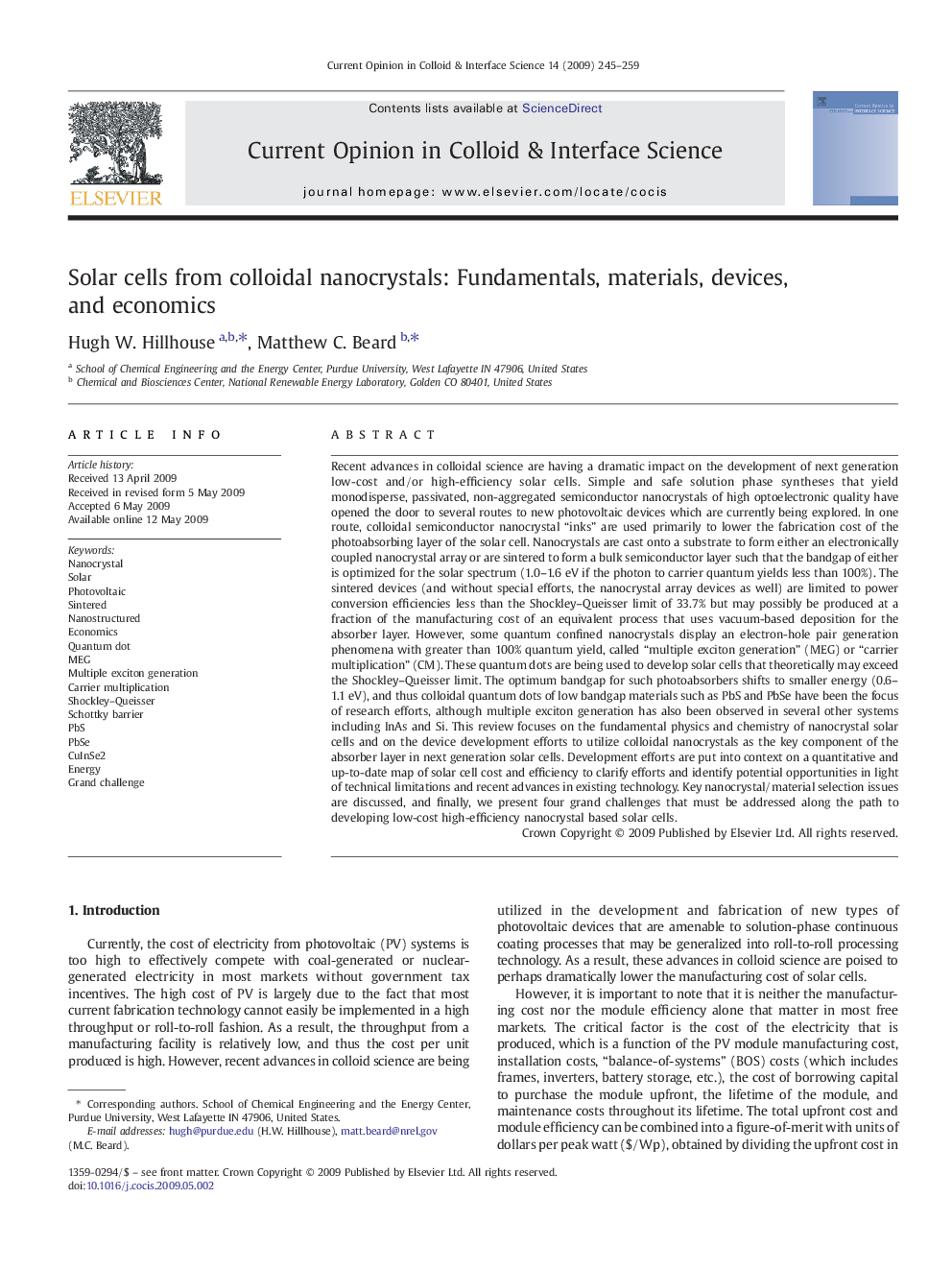| کد مقاله | کد نشریه | سال انتشار | مقاله انگلیسی | نسخه تمام متن |
|---|---|---|---|---|
| 603245 | 880198 | 2009 | 15 صفحه PDF | دانلود رایگان |
عنوان انگلیسی مقاله ISI
Solar cells from colloidal nanocrystals: Fundamentals, materials, devices, and economics
دانلود مقاله + سفارش ترجمه
دانلود مقاله ISI انگلیسی
رایگان برای ایرانیان
کلمات کلیدی
PBSPbSeCuInSe2Grand challengeCarrier multiplicationEnergy - انرژیMEG - بهSolar - خورشیدیEconomics - علم اقتصادPhotovoltaic - فتوولتائیکSchottky barrier - مانع شاتکیNanostructured - نانوساختارnanocrystal - نانوکریستالMultiple exciton generation - نسل اکسایتون چندگانهquantum dot - نقطه کوانتومیSintered - پیچ خورده
موضوعات مرتبط
مهندسی و علوم پایه
مهندسی شیمی
شیمی کلوئیدی و سطحی
پیش نمایش صفحه اول مقاله

چکیده انگلیسی
Recent advances in colloidal science are having a dramatic impact on the development of next generation low-cost and/or high-efficiency solar cells. Simple and safe solution phase syntheses that yield monodisperse, passivated, non-aggregated semiconductor nanocrystals of high optoelectronic quality have opened the door to several routes to new photovoltaic devices which are currently being explored. In one route, colloidal semiconductor nanocrystal “inks” are used primarily to lower the fabrication cost of the photoabsorbing layer of the solar cell. Nanocrystals are cast onto a substrate to form either an electronically coupled nanocrystal array or are sintered to form a bulk semiconductor layer such that the bandgap of either is optimized for the solar spectrum (1.0-1.6Â eV if the photon to carrier quantum yields less than 100%). The sintered devices (and without special efforts, the nanocrystal array devices as well) are limited to power conversion efficiencies less than the Shockley-Queisser limit of 33.7% but may possibly be produced at a fraction of the manufacturing cost of an equivalent process that uses vacuum-based deposition for the absorber layer. However, some quantum confined nanocrystals display an electron-hole pair generation phenomena with greater than 100% quantum yield, called “multiple exciton generation” (MEG) or “carrier multiplication” (CM). These quantum dots are being used to develop solar cells that theoretically may exceed the Shockley-Queisser limit. The optimum bandgap for such photoabsorbers shifts to smaller energy (0.6-1.1Â eV), and thus colloidal quantum dots of low bandgap materials such as PbS and PbSe have been the focus of research efforts, although multiple exciton generation has also been observed in several other systems including InAs and Si. This review focuses on the fundamental physics and chemistry of nanocrystal solar cells and on the device development efforts to utilize colloidal nanocrystals as the key component of the absorber layer in next generation solar cells. Development efforts are put into context on a quantitative and up-to-date map of solar cell cost and efficiency to clarify efforts and identify potential opportunities in light of technical limitations and recent advances in existing technology. Key nanocrystal/material selection issues are discussed, and finally, we present four grand challenges that must be addressed along the path to developing low-cost high-efficiency nanocrystal based solar cells.
ناشر
Database: Elsevier - ScienceDirect (ساینس دایرکت)
Journal: Current Opinion in Colloid & Interface Science - Volume 14, Issue 4, August 2009, Pages 245-259
Journal: Current Opinion in Colloid & Interface Science - Volume 14, Issue 4, August 2009, Pages 245-259
نویسندگان
Hugh W. Hillhouse, Matthew C. Beard,